OPERATION SWANLAKE
(2028
- 2029)
STAMP USED IN DESIGNS OF IMATI TIME TRAVEL EQUIPMENT:
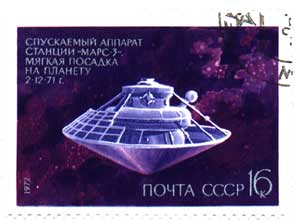
Used in design of : Psychotronic
Transmitter Chamber 2
Soviet Space Stamp, issued 1971, depicting
Mars 3 Re-entry Module.
Mars 3
Mars
3 was launched towards Mars from a Tyazheliy Sputnik (71-049C) Earth
orbiting platform. A mid-course correction was made on 8 June. The descent
module (71-049F) was released at 09:14 UT on 2 December 1971, 4 hours
35 minutes before reaching Mars. The descent module entered the martian
atmosphere at roughly 5.7 km/s. Through aerodynamic braking, parachutes,
and retro-rockets, the lander achieved a soft landing at 45 S, 158 W and
began operations. However, after 20 sec the instruments stopped working
for unknown reasons, perhaps as a result of the massive surface dust storms
raging at the time of landing. Meanwhile, the orbiter had suffered from
a partial loss of fuel and did not have enough to put itself into a planned
25 hour orbit. The engine instead performed a truncated burn to put the
spacecraft into a long 12 day, 19 hour period orbit about Mars with an
inclination thought to be similar to that of Mars 2 (48.9 degrees). The
Mars 2 and 3 orbiters sent back a large volume of data covering the period
from December 1971 to March 1972, although transmissions continued through
August. It was announced that Mars 2 and 3 had completed their missions
by 22 August 1972, after 362 orbits completed by Mars 2 and 20 orbits
by Mars 3. The probes sent back a total of 60 pictures. The images and
data revealed mountains as high as 22 km, atomic hydrogen and oxygen in
the upper atmosphere, surface temperatures ranging from -110 C to +13
C, surface pressures of 5.5 to 6 mb, water vapor concentrations 5000 times
less than in Earth's atmosphere, the base of the ionosphere starting at
80 to 110 km altitude, and grains from dust storms as high as 7 km in
the atmosphere. The data enabled creation of surface relief maps, and
gave information on the martian gravity and magnetic fields.
Sponsoring Agencies/Countries
Unknown/U.S.S.R
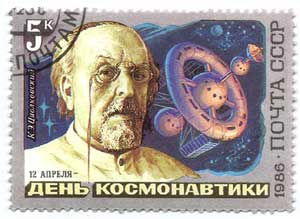
Used
in design of : Psychotronic
Transmitter Chamber 3
Soviet Space Stamp, issued 1986
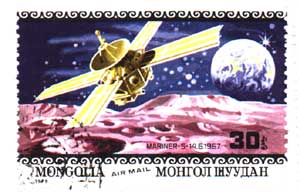
Used
in design of International
Time Travel Teleporter
Mongolian Space Stamp, issued 1967, depicting Mariner 5
Mariner
5
The Mariner
5 spacecraft was launched June 14, 1967, and flew by Venus on October
19 of that year at a distance of 4,000 kilometers (2,480 miles).
The Mariner 5 spacecraft was the fifth in a series of spacecraft used
for planetary exploration in the flyby mode. Mariner 5 was a refurbished
backup spacecraft for the Mariner 4 mission and was converted from a Mars
mission to a Venus mission. The spacecraft was fully attitude stabilized,
using the Sun and Canopus as references. A central computer and sequencer
subsystem supplied timing sequences and computing services for other spacecraft
subsystems. Mariner 5 was launched on June 14, 1967, and arrived in the
vicinity of Venus on October 19, 1967. The spacecraft carried a complement
of experiments to probe Venus's atmosphere with radio waves, scan its
brightness in ultraviolet light, and sample the solar particles and magnetic
field fluctuations above the planet. The closest flyby distance was 3,990
kilometers (2,480 miles) and, with more sensitive instruments than its
predecessor, Mariner 5 was able to shed new light on the hot, cloud-covered
planet and on conditions in interplanetary space. The spacecraft also
advanced the techniques of building and operating interplanetary spacecraft,
as had each Mariner before it. All operations of Mariner 5 were closed
out in November 1967. (Courtesy NASA/JPL)
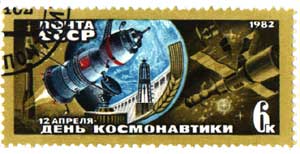
used
in design of Swan
Lake - Interplanetary Sonic Artillery Capsule
Soviet Space
Stamp, issued 1982, depicting Soyuz 19
Soyuz
The longest serving manned spacecraft in the world, the Soyuz
was originally conceived in Sergei Korolev's OKB-1 design bureau for the
Soviet effort to explore the Moon at the beginning of the 1960s. However,
long after the Moon race was over, the Soyuz continued ferrying Russian
crews to the Salyut and Almaz orbital stations, as well as it performed
several solo flights and the historic docking
with the US Apollo spacecraft in 1975.
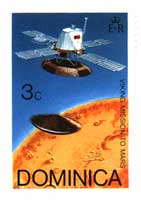
used in design
of Swan Lake - Interplanetary
Sonic Artillery Capsule
(Pre-independence)
Dominican stamp depicting Viking Mission to Mars 1975/6
Viking
Mission to Mars
NASA's
Viking Mission to Mars was composed of two spacecraft, Viking 1 and Viking
2, each consisting of an orbiter
and a lander. The primary mission objectives were to obtain high resolution
images of the Martian surface, characterize the structure and composition
of the atmosphere and surface, and search for evidence of life. Viking
1 was launched on August 20, 1975 and arrived at Mars on June 19, 1976.
The first month of orbit was devoted to imaging the surface to find appropriate
landing sites for the Viking Landers. On July 20, 1976 the Viking 1 Lander
separated from the Orbiter and touched down at Chryse Planitia (22.48°
N, 49.97° W planetographic, 1.5 km below the datum (6.1 mbar) elevation).
Viking 2 was launched September 9, 1975 and entered Mars orbit on August
7,
1976.
The Viking 2 Lander touched down at Utopia Planitia (47.97° N, 225.74°
W, 3 km below the datum elevation) on September 3, 1976. The Orbiters
imaged the entire surface of Mars at a resolution of 150 to 300 meters,
and selected areas at 8 meters. The lowest periapsis altitude for both
Orbiters was 300 km. The Viking 2 Orbiter was powered down on July 25,
1978 after 706 orbits, and the Viking 1 Orbiter on August 17, 1980, after
over 1400 orbits.

used
in design of Swan
Lake - Interplanetary Sonic Artillery launcher
North Korean
Space stamp, issued 1964, depicting Elektron A
Elektron-A
Class: Earth. Type: Magnetosphere. Nation: USSR. Agency: NII-88. Manufacturer:
Korolev.
The Elektron mission was one of the earliest Soviet satellites to be authorized
following the initial Sputnik series. The two spacecraft were designed
to be deployed in a single launch of a Vostok booster. The spacecraft
had the specific task of mapping the Van Alen radiation belts at higher
inclinations than that achieved by US satellites of the time (60 degrees
vs 30 degrees latitude). Decrees authorizing design and building of the
Elektrons were issued on 9 May 1960 and 13 May 1961. Design work began
in July 1960. Elektron A, with a design mass of 350 kg, was 325 mm in
diameter and was designed to be placed in a 425 km x 6,000 km orbit and
map the inner Van Allen belt, simultaneous with Elektron B's study of
the outer radiation belt. The spacecraft also measured cosmic rays and
the upper atmosphere.
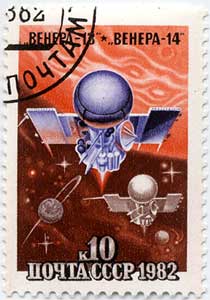
Used
in design of : Psychotronic
Transmitter Chamber 4
Soviet Space Stamp, issued 1982
Venera 14 - Soviet Venu Program
Venera 14
Launch site: Tyuratam
Launch date: 4 November 1981
Landing date: 5 March 1982
Period 361 days
The Venera descent module landed at 13 degrees 15 minutes south latitude/310
degrees 9 minutes longitude. The probe transmitted data via its fly-by
bus for 57 minutes.
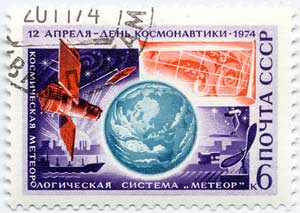
Used
in design of : Psychotronic
Transmitter Chamber 4
Soviet Space Stamp, issued 1974
© Institute of Militronics and Advanced Time Interventionality 2058
back
to OPERATION SWANLAKE textpage
Time Travel Research Projects
menu